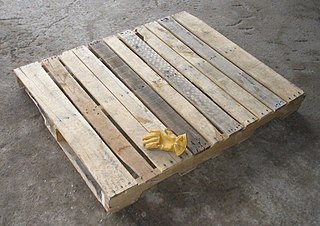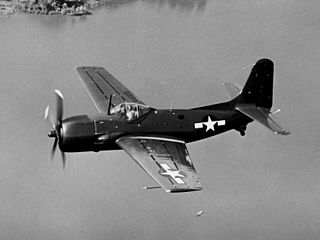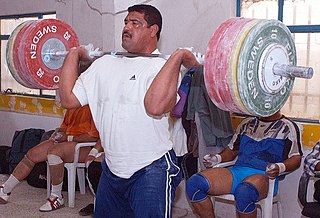
A 19-inch rack is a standardized frame or enclosure for mounting multiple electronic equipment modules. Each module has a front panel that is 19 inches (482.6 mm) wide. The 19 inch dimension includes the edges or ears that protrude from each side of the equipment, allowing the module to be fastened to the rack frame with screws or bolts. Common uses include computer servers, telecommunications equipment and networking hardware, audiovisual production gear, music production equipment, and scientific equipment.

Plywood is a composite material manufactured from thin layers, or "plies", of wood veneer that are glued together with adjacent layers, having their wood grain rotated up to 90° to one another. It is an engineered wood from the family of manufactured boards, which include medium-density fibreboard (MDF), oriented strand board (OSB), and particle board.

A jerrycan or jerrican is a robust liquid container made from pressed steel. It was designed in Germany in the 1930s for military use to hold 20 litres of fuel, and saw widespread use by both Germany and the Allies during the Second World War.

Ultrasonic welding is an industrial process whereby high-frequency ultrasonic acoustic vibrations are locally applied to work pieces being held together under pressure to create a solid-state weld. It is commonly used for plastics and metals, and especially for joining dissimilar materials. In ultrasonic welding, there are no connective bolts, nails, soldering materials, or adhesives necessary to bind the materials together. When used to join metals, the temperature stays well below the melting point of the involved materials, preventing any unwanted properties which may arise from high temperature exposure of the metal.

The Apollo command and service module (CSM) was one of two principal components of the United States Apollo spacecraft, used for the Apollo program, which landed astronauts on the Moon between 1969 and 1972. The CSM functioned as a mother ship, which carried a crew of three astronauts and the second Apollo spacecraft, the Apollo Lunar Module, to lunar orbit, and brought the astronauts back to Earth. It consisted of two parts: the conical command module, a cabin that housed the crew and carried equipment needed for atmospheric reentry and splashdown; and the cylindrical service module which provided propulsion, electrical power and storage for various consumables required during a mission. An umbilical connection transferred power and consumables between the two modules. Just before reentry of the command module on the return home, the umbilical connection was severed and the service module was cast off and allowed to burn up in the atmosphere.

A baler or hay baler is a piece of farm machinery used to compress a cut and raked crop into compact bales that are easy to handle, transport, and store. Often, bales are configured to dry and preserve some intrinsic value of the plants bundled. Different types of balers are commonly used, each producing a different type of bale – rectangular or cylindrical, of various sizes, bound with twine, strapping, netting, or wire.

Plastic welding is welding for semi-finished plastic materials, and is described in ISO 472 as a process of uniting softened surfaces of materials, generally with the aid of heat. Welding of thermoplastics is accomplished in three sequential stages, namely surface preparation, application of heat and pressure, and cooling. Numerous welding methods have been developed for the joining of semi-finished plastic materials. Based on the mechanism of heat generation at the welding interface, welding methods for thermoplastics can be classified as external and internal heating methods, as shown in Fig 1.

A pallet is a flat transport structure, which supports goods in a stable fashion while being lifted by a forklift, a pallet jack, a front loader, a jacking device, or an erect crane. A pallet is the structural foundation of a unit load, which allows handling and storage efficiencies. Goods in shipping containers are often placed on a pallet secured with strapping, stretch wrap or shrink wrap and shipped. Since its invention in the twentieth century, its use has dramatically supplanted older forms of crating like the wooden box and the wooden barrel, as it works well with modern packaging like corrugated boxes and intermodal containers commonly used for bulk shipping. In addition, pallet collars can be used to support and protect items shipped and stored on pallets.

Strapping, also known as bundling and banding, is the process of applying a strap to an item to combine, stabilize, hold, reinforce, or fasten it. A strap may also be referred to as strapping. Strapping is most commonly used in the packaging industry.

The Ordnance SBML two-inch mortar, or more commonly, just "two-inch mortar", was a British mortar issued to the British Army and the Commonwealth armies, that saw use during the Second World War and later.

Intermediate bulk containers are industrial-grade containers engineered for the mass handling, transport, and storage of liquids, semi-solids, pastes, or solids. The two main categories of IBC tanks are flexible IBCs and rigid IBCs. Many IBCs are reused or repurposed.

The W50 was an American thermonuclear warhead deployed on the MGM-31 Pershing theater ballistic missile. Initially developed for the LIM-49 Nike Zeus anti-ballistic missile, this application was cancelled before deployment. The W50 was developed by Los Alamos National Laboratory. The W50 was manufactured from 1963 through 1965, with a total of 280 being produced. They were retired from service starting in 1973 with the last units retired in 1991.

Package cushioning is used to protect items during shipment. Vibration and impact shock during shipment and loading/unloading are controlled by cushioning to reduce the chance of product damage.

The term unit load refers to the size of an assemblage into which a number of individual items are combined for ease of storage and handling, for example a pallet load represents a unit load which can be moved easily with a pallet jack or forklift truck, or a container load represents a unit for shipping purposes. A unit load can be packed tightly into a warehouse rack, intermodal container, truck or boxcars, yet can be easily broken apart at a distribution point, usually a distribution center, wholesaler, or retail store for sale to consumers or for use.

The Curtiss XBT2C was a prototype two-seat, single-engined dive/torpedo bomber developed during World War II for the United States Navy. Derived from the Curtiss SB2C Helldiver dive bomber, it was an unsuccessful competitor to meet a 1945 Navy specification for an aircraft to combine the roles that previously required separate types. Unlike the other competitors, the XBT2C was designed to accommodate a radar operator.

A transit case is a hard-sided case intended for protecting and concealing defined contents during transportation. In some forms, the interior is filled with foam which has pockets molded or cut into it that equipment specifically fits into. Some transit cases are provided with foam inserts that completely fill the interior and the user can pluck out pieces to make the case fit a particular application. Many camera cases are built in this fashion allowing the user to tailor the interior foam to their particular equipment. The outside of the transit case provides protection against the environment and a first level of protection against mechanical damage such as shock. The interior foam or other structure cushions the equipment against shock and vibration and some protection against rapid temperature changes.

Package testing or packaging testing involves the measurement of a characteristic or property involved with packaging. This includes packaging materials, packaging components, primary packages, shipping containers, and unit loads, as well as the associated processes.

The Knight XV is a hand-built luxury SUV, produced by Conquest Vehicles since 2008. It is Conquest Vehicles' flagship product.

A weight plate is a flat, heavy object, usually made of cast iron, that is used in combination with barbells or dumbbells to produce a bar with a desired total weight for the purpose of physical exercise.
The Pennsylvania Railroad's class K29s comprised a single experimental 4-6-2 "Pacific" type steam locomotive. Constructed by Alco-Schenectady, it was given road number 3395. Although only one demonstrator was constructed, the K29s would become the basis for the highly successful K4s Pacifics and L1s Mikados. The lone example spent most of its life on the PRR's Pittsburgh division main line and was retired around 1929.




















